“Nepal’s innovation lies in finding problems, ideating solutions and creating innovations to create those solutions”
LEANNE GLUCK, Deputy Director of America Makes is not a new name to 3D technology. Gluck was involved with 3D System as the Director of Social Impact before joining America Makes. She was here in Nepal for the inauguration of ‘Makerspace’ at the Innovation Hub in Teku.
She spoke to Avipsha Rayamajhi on the opportunities that Makerspace will create in Nepal to promote the entrepreneurial ecosystem.
Excerpts:
What is the main reason for your visit to Nepal?
I am here as the speaker of Makerspace for the Embassy of the United States of America. I have had a huge range of exposure to Makerspaces in the USA, so I am here to collaborate and support the growth of such platforms.
Having worked in the area of 3D technology, I have been talking about STEM education and entrepreneurship with the youth of different educational institutions. Along with that, I had a series of interactions with women involved in technology.
What is the vision of America Makes and what is your role as the Deputy Director in the company?
America Makes is the national additive manufacturing institute in the USA. Started in 2012 by the Obama Administration, it is focussed around accelerating the adaption of 3D printing and additive manufacturing in the USA. It has three major points of focus — technology, research and development; commercialisation, and work force and education.
As the Deputy Director of workforce and educational outreach in the company, I focus on bringing 3D printing across school and university level. We are creating a workforce in the education road map to integrate 3D technology across the world. We are working with members of industry, academia, non-profits and government and trying to understand knowledge, skills and experiences individuals need in order to understand and integrate the use of 3D printers.
Through innovation factory, we look at outcome based training models to help support industries integrate 3D printing. As an organisation, we also fund educational, commercial and tech projects. So I help to create architecture for that funding. We are also creating an online 3D textbook which will be co-created by our experts of 3D printing.
How do you think 3D printing can revolutionise development?
3D printing brings your imagination to life. It is one tool in a big tool box of maker technology. There are a couple of reasons why 3D printing is so interesting. The first one being that it allows for small batch manufacturing, 3D technology shortens the supply chain. It makes production much quicker, cheaper and can be customised as per your desire. So you can visualise something on your own and create it without a huge investment.
How can Nepal benefit from 3D printing?
I think Nepal is already benefitting from 3D prinitng. Nepal’s innovation lies in finding problems, ideating solutions and creating innovations to create those solutions. And that is exactly what 3D printing is all about. Through 3D printing, you have the opportunity to use digital designs to create physical solutions.
Field Ready, a non-profit organisationin the USA is helping Nepal benefit through using 3D printing for local batch manufacturing, specifically in the area of health care. They work to build connections between local manufacturers and suppliers. Presently, in Nepal, 3D printing is being used for medical modelling purposes. Kathmandu University is using 3D printing to support a wind turbine project and create a product specific to Nepal around wind turbine.
What are your thoughts on Makerspace and how does it connect technology, business and investments?
Makerspace is a place where you can connect to technology and other individuals who are doing similar things so that you can communicate and collaborate. It allows you space where you can prototype your products and collaborate with other makers. It is across the whole spectrum of access to technology and access to collaboration and sharing that you have created.
What does Nepal stand to benefit from a platform such as Makerspace?
I think they benefit in quite a number of ways. You have access to technology and other makers. Makerspace in Teku is facilitated with 3D printers and laser cutters that help youth be exposed to new technology. That is huge in a maker movement because we learn from sharing ideas.
Innovation ecosystems such as Makerspace are the key to creating new products. So communities in Nepal inclined to technology have access to a platform equipped with scientific technology where they can exchange ideas and collaborate to make their imagination real.
Tell us about the Mini Maker Fair happening in Kathmandu on September 24 and 25.
I am very excited about the event. It is the first-of-its-kind in Nepal that is really focussed on social innovation and products that help make an impact on the community. We will get to witness a collection of creative solutions from all across Nepal. I think it’s going to be incredible!
It will have a huge impact on Nepal and spark a new conversation in the global community.






